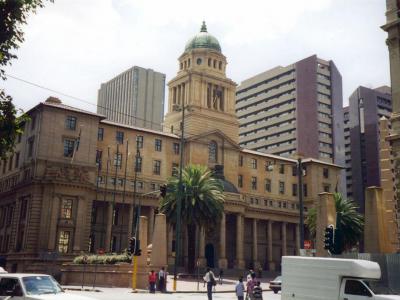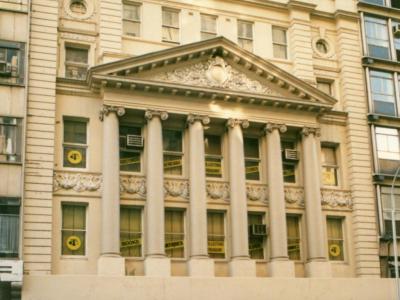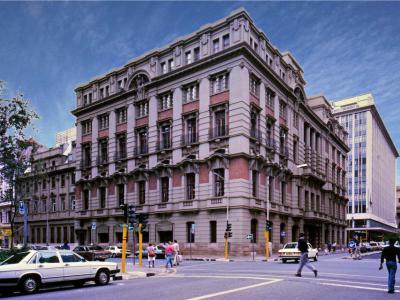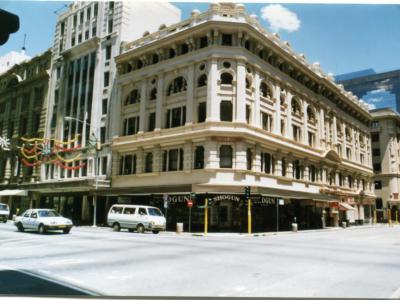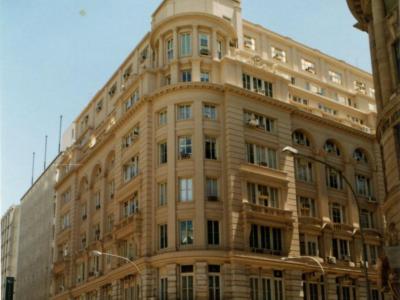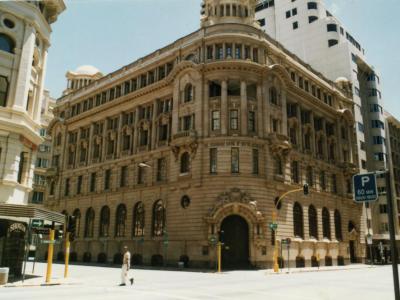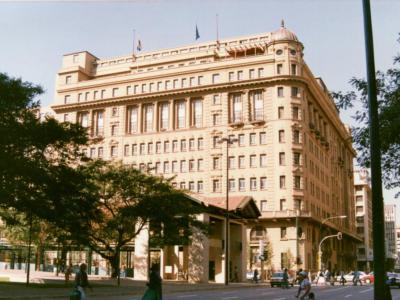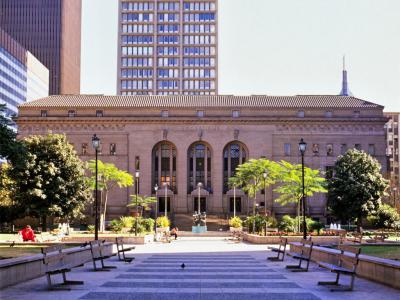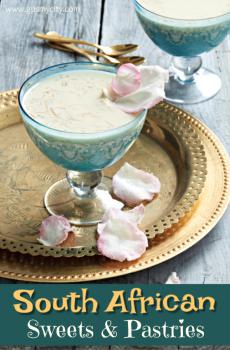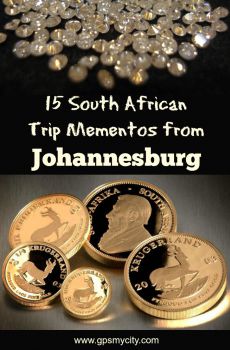Historical Buildings Walking Tour (Self Guided), Johannesburg
Since founded in 1886, following the discovery of gold on what used to be farmland, Johannesburg has evolved into an economic powerhouse of Africa. While most of the city's early buildings adopted architectural styles from its colonial parent, the British Empire, some of them also emulated the prowess of New York City. Let's take a closer look at some of these construction marvels.
The imposing Johannesburg City Hall, built in 1914, is a Neo-Renaissance structure. A symbol of civic pride, it has been a hub for various cultural and political events over the years.
Another architectural gem from the same period, Johannesburg Trades Hall, has served as a gathering place for labor unions and workers' movements. It represents the city's labor history and the fight for workers' rights.
The Rand Club, established in 1887, is a prestigious social club housed in a grand Victorian-era edifice. It played a significant role in the city's high society and business circles during the gold rush era.
Meanwhile, the Victory House, constructed in the 1890s, is a fine example of the so-called Creative Eclectic Style. It represents an expression of the Victorian desire for a new style to meet the challenges of a new era.
Found near it, the Consolidated Building, dating back to the early 20th century, is an elegant piece of the “American office block” style in South Africa.
The Standard Bank Building, completed in 1908, is a handsome stone-faced structure that signifies the city's economic growth and prominence. It features the Beaux Arts Style design which dominated Central London at the end of the 19th century.
The historic National Bank Building, constructed in 1904, exemplifies late Victorian Neo-Classical architecture. The building reflects the city's banking history and its role as a financial center.
Finally, the Johannesburg City Library, established in 1935, is a beautiful, Italianate structure, offering a serene space for learning and research.
Exploring these architectural jewels and discovering their stories can tell you a lot about Johannesburg's eventful past and contribute to your understanding of its unique character. So, take this self-guided tour now and learn more about this exciting city.
The imposing Johannesburg City Hall, built in 1914, is a Neo-Renaissance structure. A symbol of civic pride, it has been a hub for various cultural and political events over the years.
Another architectural gem from the same period, Johannesburg Trades Hall, has served as a gathering place for labor unions and workers' movements. It represents the city's labor history and the fight for workers' rights.
The Rand Club, established in 1887, is a prestigious social club housed in a grand Victorian-era edifice. It played a significant role in the city's high society and business circles during the gold rush era.
Meanwhile, the Victory House, constructed in the 1890s, is a fine example of the so-called Creative Eclectic Style. It represents an expression of the Victorian desire for a new style to meet the challenges of a new era.
Found near it, the Consolidated Building, dating back to the early 20th century, is an elegant piece of the “American office block” style in South Africa.
The Standard Bank Building, completed in 1908, is a handsome stone-faced structure that signifies the city's economic growth and prominence. It features the Beaux Arts Style design which dominated Central London at the end of the 19th century.
The historic National Bank Building, constructed in 1904, exemplifies late Victorian Neo-Classical architecture. The building reflects the city's banking history and its role as a financial center.
Finally, the Johannesburg City Library, established in 1935, is a beautiful, Italianate structure, offering a serene space for learning and research.
Exploring these architectural jewels and discovering their stories can tell you a lot about Johannesburg's eventful past and contribute to your understanding of its unique character. So, take this self-guided tour now and learn more about this exciting city.
How it works: Download the app "GPSmyCity: Walks in 1K+ Cities" from Apple App Store or Google Play Store to your mobile phone or tablet. The app turns your mobile device into a personal tour guide and its built-in GPS navigation functions guide you from one tour stop to next. The app works offline, so no data plan is needed when traveling abroad.
Historical Buildings Walking Tour Map
Guide Name: Historical Buildings Walking Tour
Guide Location: South Africa » Johannesburg (See other walking tours in Johannesburg)
Guide Type: Self-guided Walking Tour (Sightseeing)
# of Attractions: 8
Tour Duration: 1 Hour(s)
Travel Distance: 0.7 Km or 0.4 Miles
Author: jenny
Sight(s) Featured in This Guide:
Guide Location: South Africa » Johannesburg (See other walking tours in Johannesburg)
Guide Type: Self-guided Walking Tour (Sightseeing)
# of Attractions: 8
Tour Duration: 1 Hour(s)
Travel Distance: 0.7 Km or 0.4 Miles
Author: jenny
Sight(s) Featured in This Guide:
- Johannesburg City Hall
- Johannesburg Trades Hall
- Rand Club
- Victory House
- Consolidated Building
- Standard Bank Building
- National Bank Building
- Johannesburg City Library
1) Johannesburg City Hall
Johannesburg City Hall was constructed between 1910 and 1914. This building has enjoyed National Monument status since 1979. The style is known as Edwardian Baroque, with distinctive features like a neo-Renaissance half-dome entrance and a portico featuring Ionic columns. A two-half design places the Town Hall and municipal offices on opposite sides.
There is a paved square in front of the main entrance, with obelisks and a fountain. Visitors will appreciate the collection of mosaics and the marble used to decorate the vestibule. Two staircases lead up to the gallery area.
The Town Hall area features decorative gilding, plaster, and woodwork that are still impressive to see. One of the highlights of this area is a Norman & Beard of Norwich-built pipe organ that was used for recitals during the 1920s. This organ once enjoyed status as the largest organ in Africa and the second-largest organ in the Southern Hemisphere.
There is a paved square in front of the main entrance, with obelisks and a fountain. Visitors will appreciate the collection of mosaics and the marble used to decorate the vestibule. Two staircases lead up to the gallery area.
The Town Hall area features decorative gilding, plaster, and woodwork that are still impressive to see. One of the highlights of this area is a Norman & Beard of Norwich-built pipe organ that was used for recitals during the 1920s. This organ once enjoyed status as the largest organ in Africa and the second-largest organ in the Southern Hemisphere.
2) Johannesburg Trades Hall
Located in the heart of Johannesburg, the Johannesburg Trades Hall is a remarkable symbol of the city's architectural history and its significant role in labor history. This venerable building, which dates back to the Edwardian era, has withstood the test of time and stands today as one of the city's oldest and most beloved landmarks. Beyond its appealing architectural features, the Johannesburg Trades Hall holds a rich history, having once served as the prestigious headquarters of Trade Unions. Its walls resonate with the echoes of labor struggles and social movements, particularly during the turbulent Rand Revolt of 1922.
Acknowledged for its historical and architectural importance, this revered structure earned a coveted spot on Johannesburg's "100 most important heritage buildings" list in 1986, a testament to its enduring legacy and continued significance in the city's cultural and historical context.
Acknowledged for its historical and architectural importance, this revered structure earned a coveted spot on Johannesburg's "100 most important heritage buildings" list in 1986, a testament to its enduring legacy and continued significance in the city's cultural and historical context.
3) Rand Club
The Rand Club, established in October 1887, holds the distinction of being the oldest private members' club in Johannesburg. In 1902, plans were drawn up for the construction of its third clubhouse, which was subsequently completed in 1904.
The current clubhouse, designed by architects William Leck and Frank Emley, combines Edwardian Neo-Baroque style with inspiration from Michelangelo's Church of the Sacred Heart in Florence and the Reform Club in London. The front facade has a rustic ground floor with porticoes and Doric pillars. Two half-moon wooden benches by the front doors, a tradition since 1904, were used by members to observe street life.
This six-story building offers an array of impressive facilities, including Africa's longest bar at 31 meters (103 feet), a billiards room, private theater, grand staircase with a mosaic dome, two libraries, a ballroom, armory, six conference rooms, offices, and three bedrooms. Regrettably, the top two floors are still undergoing restoration after a fire in June 2005, which also led to the loss of a notable Pietro Annigoni portrait of Queen Elizabeth II. Nevertheless, the club's interiors showcase artworks by prominent South African artists, past and present.
The Buckland Library in Johannesburg boasts a collection of over 10,000 historically significant books, some from the 19th century. It's a valuable resource for African topics, Johannesburg history, and biographies. The library also features works by club members like Sir Lionel Phillips and Anthony Akerman.
One unique aspect of the club's history is that it served as the official residence for members of the British royal family on two occasions during their official visits to South Africa in the 1920s and 1930s.
The current clubhouse, designed by architects William Leck and Frank Emley, combines Edwardian Neo-Baroque style with inspiration from Michelangelo's Church of the Sacred Heart in Florence and the Reform Club in London. The front facade has a rustic ground floor with porticoes and Doric pillars. Two half-moon wooden benches by the front doors, a tradition since 1904, were used by members to observe street life.
This six-story building offers an array of impressive facilities, including Africa's longest bar at 31 meters (103 feet), a billiards room, private theater, grand staircase with a mosaic dome, two libraries, a ballroom, armory, six conference rooms, offices, and three bedrooms. Regrettably, the top two floors are still undergoing restoration after a fire in June 2005, which also led to the loss of a notable Pietro Annigoni portrait of Queen Elizabeth II. Nevertheless, the club's interiors showcase artworks by prominent South African artists, past and present.
The Buckland Library in Johannesburg boasts a collection of over 10,000 historically significant books, some from the 19th century. It's a valuable resource for African topics, Johannesburg history, and biographies. The library also features works by club members like Sir Lionel Phillips and Anthony Akerman.
One unique aspect of the club's history is that it served as the official residence for members of the British royal family on two occasions during their official visits to South Africa in the 1920s and 1930s.
4) Victory House
Victory House, originally named Permanent Buildings, stands in Marshalltown and holds immense historical and architectural significance. It is renowned for housing Johannesburg's inaugural elevator.
Initially, constructed and christened Permanent Building by the South African Permanent Mutual and Investment Society, which originated in Kimberley in November 1883, with the primary goal of aiding individuals of limited means in acquiring property and establishing a place for savings deposits that could generate interest. The first branch opened its doors in Johannesburg in 1889 and later relocated to the new five-story structure, now recognized as Victory House, in 1897.
Victory House is a prime example of Stucke's architectural work, representing a bold and aesthetically pleasing classical building. In this structure, Stucke artfully amalgamated and adapted elements from various architectural styles, resulting in a novel composition known as the Creative Eclectic Style-a manifestation of the Victorian era's aspiration for a new architectural style to address the challenges of its time. The building boasts several characteristic features of a Colonial Victorian structure, such as corrugated iron roofing, ornate wrought iron embellishments, and red brickwork. While the brickwork has been covered with paint, its original outline remains discernible.
Initially, constructed and christened Permanent Building by the South African Permanent Mutual and Investment Society, which originated in Kimberley in November 1883, with the primary goal of aiding individuals of limited means in acquiring property and establishing a place for savings deposits that could generate interest. The first branch opened its doors in Johannesburg in 1889 and later relocated to the new five-story structure, now recognized as Victory House, in 1897.
Victory House is a prime example of Stucke's architectural work, representing a bold and aesthetically pleasing classical building. In this structure, Stucke artfully amalgamated and adapted elements from various architectural styles, resulting in a novel composition known as the Creative Eclectic Style-a manifestation of the Victorian era's aspiration for a new architectural style to address the challenges of its time. The building boasts several characteristic features of a Colonial Victorian structure, such as corrugated iron roofing, ornate wrought iron embellishments, and red brickwork. While the brickwork has been covered with paint, its original outline remains discernible.
5) Consolidated Building
The Consolidated Building, affectionately known as 'Johnnies,' is an office building located in the Marshalltown district of Johannesburg, specifically occupying stands 149, 150, and 152 at the intersection of Fox Street and Harrison Street. Before the construction of the Consolidated Building in 1904, these stands were home to the Jewish Social Club in 1895 and the Johannesburg Waterworks offices in 1897.
The architectural design of the Consolidated Building was the work of Theo H. Smith from London, overseen by the architects Aburrow and Treeby from Johannesburg. It was completed in 1906, featuring eight stories and an eye-catching rounded corner entrance at the intersection of Fox Street and Harrison Street. Originally, it had six stories, as indicated by the cornice with dentil detailing. In 1935, an additional two stories were added to the top, resulting in the loss of the original small dome on the corner tower. These added stories are distinguishable from the original structure due to their setback from the facade and the use of a lighter-colored material for the elevations.
The Consolidated Building's facades are constructed with brick and adorned with plaster embellishments, while a polished grey granite plinth adds to its aesthetic appeal. The vertical elements on the building's exterior reflect its internal steel framework. This building represents a prime example of the American office block style and is likely one of the earliest instances of this style in South Africa. It draws inspiration from the 'Chicago Style of America,' and its facade design bears a distinct resemblance to Adler & Sullivan's Auditorium Building (1887-9) in Chicago.
Presently, the Consolidated Building is owned by Dreamworld Investments 374 and holds a Grade A- listing from the Institute of South African Architects, recognizing its significance as a heritage asset.
The architectural design of the Consolidated Building was the work of Theo H. Smith from London, overseen by the architects Aburrow and Treeby from Johannesburg. It was completed in 1906, featuring eight stories and an eye-catching rounded corner entrance at the intersection of Fox Street and Harrison Street. Originally, it had six stories, as indicated by the cornice with dentil detailing. In 1935, an additional two stories were added to the top, resulting in the loss of the original small dome on the corner tower. These added stories are distinguishable from the original structure due to their setback from the facade and the use of a lighter-colored material for the elevations.
The Consolidated Building's facades are constructed with brick and adorned with plaster embellishments, while a polished grey granite plinth adds to its aesthetic appeal. The vertical elements on the building's exterior reflect its internal steel framework. This building represents a prime example of the American office block style and is likely one of the earliest instances of this style in South Africa. It draws inspiration from the 'Chicago Style of America,' and its facade design bears a distinct resemblance to Adler & Sullivan's Auditorium Building (1887-9) in Chicago.
Presently, the Consolidated Building is owned by Dreamworld Investments 374 and holds a Grade A- listing from the Institute of South African Architects, recognizing its significance as a heritage asset.
6) Standard Bank Building
The Standard Bank Building boasts an impressive stone-faced design influenced by the late Victorian neo-Baroque and Beaux Arts styles, which were gaining prominence in the late 19th century on New Regent Street and Piccadilly in London. This five-story structure exudes a formal and dignified appearance, adorned with an abundance of neo-Baroque decorations on its façade, all executed in a somewhat restrained and orderly manner. This architectural approach lends an imposing and impersonal character to the building, aligning perfectly with the prevailing sentiment of emphasizing the power and influence of the British Empire during that era.
Noteworthy features include domed crowns atop the building's corners, which are supported by classical columns in the Ionic style. The entrance at the intersection of Commissioner and Harrison Streets commands attention, featuring two oversized sculptures portraying Justice and Commerce, skillfully crafted by the Greek sculptor Marigo. The building's structural framework is composed of steel, with brick infill walls, and the exterior is clad in finely cut sandstone.
Noteworthy features include domed crowns atop the building's corners, which are supported by classical columns in the Ionic style. The entrance at the intersection of Commissioner and Harrison Streets commands attention, featuring two oversized sculptures portraying Justice and Commerce, skillfully crafted by the Greek sculptor Marigo. The building's structural framework is composed of steel, with brick infill walls, and the exterior is clad in finely cut sandstone.
7) National Bank Building
The National Bank Building, also known as the Corner House, was crafted by the acclaimed architects Leck and Emley in the year 1903, and the construction reached its completion in 1904. In the year 1902, Leck and Emley had previously undertaken the design of the adjacent Corner House building, which was finalized in 1904, strategically situated at the intersection of Simmonds and Commissioner Streets. The exterior of the newly constructed National Bank Building seamlessly harmonized with the Corner House, and it is believed that J.B. Taylor, who served as the chairman of the Corner House and concurrently held a directorship at the National Bank, advocated for the amalgamation of the two structures.
In 1953, the bank, now under the banner of Barclays, replicated Taylor's vision. They engaged Gordon Leith to conceive the third segment of the edifice - the Market Street extension. This extension was meticulously designed to align with the existing two structures, thus creating a unified and coherent complex.
The architectural style of the building is characterized by late Victorian Neo-Classical elements, highlighted by an alluring copper dome adorning the corner. Within the banking hall, a glass dome spans overhead, infusing the interior with abundant natural light, creating a spacious and luminous atmosphere. The remainder of the roofscape is comprised of a flat concrete slab. The interior design mirrors the meticulous approach to proportion, featuring exquisite craftsmanship in details like paneling and parquet flooring.
The National Bank Building has been officially recognized as a national monument by the PHRAG due to its historical and cultural significance.
In 1953, the bank, now under the banner of Barclays, replicated Taylor's vision. They engaged Gordon Leith to conceive the third segment of the edifice - the Market Street extension. This extension was meticulously designed to align with the existing two structures, thus creating a unified and coherent complex.
The architectural style of the building is characterized by late Victorian Neo-Classical elements, highlighted by an alluring copper dome adorning the corner. Within the banking hall, a glass dome spans overhead, infusing the interior with abundant natural light, creating a spacious and luminous atmosphere. The remainder of the roofscape is comprised of a flat concrete slab. The interior design mirrors the meticulous approach to proportion, featuring exquisite craftsmanship in details like paneling and parquet flooring.
The National Bank Building has been officially recognized as a national monument by the PHRAG due to its historical and cultural significance.
8) Johannesburg City Library
The Johannesburg City Library is situated in the central business district of the City of Johannesburg. The library is housed in a beautiful Italianate building designed by architect John Perry, which opened its doors in 1935. Its extensive collection boasts over 1.5 million books and various other items, with a membership base exceeding 250,000 individuals.
The library's stunning Italianate structure stands just opposite the ANC's Luthuli House. The construction of the Johannesburg Public Library occurred between 1931 and 1935, following an architectural competition that awarded Cape Town architect John Perry the winning design. The building features an impressive east-facing entrance with three imposing arches and metal doors bearing the initials "LJ" for the English "Library of Johannesburg" and "BJ" for the Afrikaans "Biblioteek Johannesburg."
Peter Kirchhoff intricately carved stone medallions of famous figures on the building's northern and southern facades. Moses Kottler added large sculptures representing various disciplines on the exterior. The building, made of stone with a terracotta roof, once had an atrium, which was replaced with a three-story addition during renovations from 2009 to 2012.
The library has an extensive collection of 1.5 million items, including 700,000 books, DVDs, CDs, sheet music, and periodicals. Recent construction expanded the floor space by 1,967 square meters to a total of 11,198 square meters, accommodating 566 visitors, up from 255. A new coffee shop and various improvements, including upgraded facilities and a transformed theater section into a conference area and a dedicated music and film viewing space, have been added.
The library's stunning Italianate structure stands just opposite the ANC's Luthuli House. The construction of the Johannesburg Public Library occurred between 1931 and 1935, following an architectural competition that awarded Cape Town architect John Perry the winning design. The building features an impressive east-facing entrance with three imposing arches and metal doors bearing the initials "LJ" for the English "Library of Johannesburg" and "BJ" for the Afrikaans "Biblioteek Johannesburg."
Peter Kirchhoff intricately carved stone medallions of famous figures on the building's northern and southern facades. Moses Kottler added large sculptures representing various disciplines on the exterior. The building, made of stone with a terracotta roof, once had an atrium, which was replaced with a three-story addition during renovations from 2009 to 2012.
The library has an extensive collection of 1.5 million items, including 700,000 books, DVDs, CDs, sheet music, and periodicals. Recent construction expanded the floor space by 1,967 square meters to a total of 11,198 square meters, accommodating 566 visitors, up from 255. A new coffee shop and various improvements, including upgraded facilities and a transformed theater section into a conference area and a dedicated music and film viewing space, have been added.
Walking Tours in Johannesburg, South Africa
Create Your Own Walk in Johannesburg
Creating your own self-guided walk in Johannesburg is easy and fun. Choose the city attractions that you want to see and a walk route map will be created just for you. You can even set your hotel as the start point of the walk.
Johannesburg Introduction Walking Tour
Johannesburg, or Joburg, or "City of Gold", as it is often informally called, is South Africa's largest city. The area's original inhabitants included hunter-gatherers from the San tribes and the Ndebele, a tribe associated with the Zulu. A gold rush in 1884 lead to Johannesburg's founding in 1886. Within a decade, the population had grown to 100,000 inhabitants.
Much... view more
Tour Duration: 1 Hour(s)
Travel Distance: 2.9 Km or 1.8 Miles
Much... view more
Tour Duration: 1 Hour(s)
Travel Distance: 2.9 Km or 1.8 Miles
Useful Travel Guides for Planning Your Trip
South African Sweets and Pastries
A melting pot of the Dutch, British and African traditions, the culture of South Africa embraces flavorful cuisine in which traditional desserts play an important role. South Africans love it sweet – be it a veggie dish or a barbecue sauce on meat, let alone purpose-made pastries that they are...
15 Uniquely South African Souvenirs to Bring Home from Johannesburg
One of the most fascinating cities in Africa, Johannesburg is a showroom for all things South African - a mixture of native and European trends, deeply rooted in local habits and traditions. To find your way around many of the delights Jo'burg has to offer and to pick up some as a remembrance...
The Most Popular Cities
/ view all



